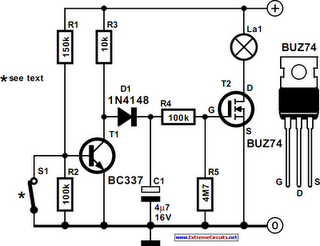Home » Circuits
Car Interior Lights Delay
Most cars do not have delayed interior lights. The circuit presented can put this right. It switches the interior lights of a car on and off gradually. This makes it a lot easier, for instance, to find the ignition keyhole when the lights have gone off after the car door has been closed. Since the circuit must be operated by the door switch, a slight intervention in the wiring of this switch is unavoidable. When the car door is opened, the door switch closes the lights circuit to earth. When the door is closed (and the switch is open), transistor T1, whose base is linked to the switch, cuts off T2, so that the interior light remains off. When the switch closes (when the door is opened), the base of T1 is at earth level and the transistor is off.Circuit diagram:

Capacitor C1 is charged fairly rapidly via R3 and D1, whereupon T2 comes on so that the interior light is switched on. When the door is closed again, T1 conducts and stops the charging of C1. However, the capacitor is discharged fairly slowly via R5, so that T2 is not turned off immediately. This ensures that the interior light remains on for a little while and then goes out slowly. The time delays may be varied quite substantially by altering the values of R3, R5, and C1. Circuit IC2 may be one of many types of n-channel power MOSFET, but it should be able to handle drain-source voltages greater than 50 V. In the proto-type, a BUZ74 is used which can handle D-S voltages of up to 500 V.
